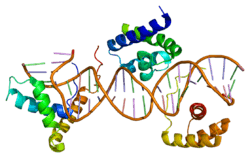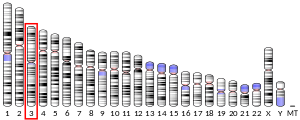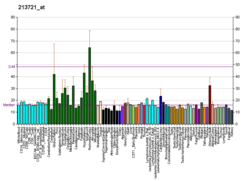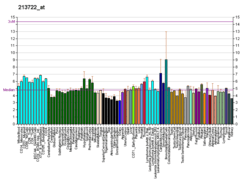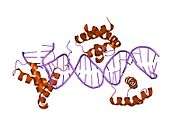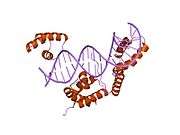SOX2
SRY (sex determining region Y)-box 2, also known as SOX2, is a transcription factor that is essential for maintaining self-renewal, or pluripotency, of undifferentiated embryonic stem cells. Sox2 has a critical role in maintenance of embryonic and neural stem cells.[4]
Sox2 is a member of the Sox family of transcription factors, which have been shown to play key roles in many stages of mammalian development. This protein family shares highly conserved DNA binding domains known as HMG (High-mobility group) box domains containing approximately 80 amino acids.[4]
Sox2 holds great promise in research involving induced pluripotency, an emerging and very promising field of regenerative medicine.[5]
Function
Stem cell pluripotency
LIF (Leukemia inhibitory factor) signaling, which maintains pluripotency in mouse embryonic stem cells, activates Sox2 downstream of the JAK-STAT signaling pathway and subsequent activation of Klf4 (a member of the family of Kruppel-like factors). Oct-4, Sox2 and Nanog positively regulate transcription of all pluripotency circuitry proteins in the LIF pathway.[6]
NPM1, a transcriptional regulator involved in cell proliferation, individually forms complexes with Sox2, Oct4 and Nanog in embryonic stem cells.[7] These three pluripotency factors contribute to a complex molecular network that regulates a number of genes controlling pluripotency. Sox2 binds to DNA cooperatively with Oct4 at non-palindromic sequences to activate transcription of key pluripotency factors.[8] Surprisingly, regulation of Oct4-Sox2 enhancers can occur without Sox2, likely due to expression of other Sox proteins. However, a group of researchers concluded that the primary role of Sox2 in embryonic stem cells is controlling Oct4 expression, and they both perpetuate their own expression when expressed concurrently.[9]
In an experiment involving mouse embryonic stem cells, it was discovered that Sox2 in conjunction with Oct4, c-Myc and Klf4 were sufficient for producing induced pluripotent stem cells.[10] The discovery that expression of only four transcription factors was necessary to induce pluripotency allowed future regenerative medicine research to be conducted considering minor manipulations.
Loss of pluripotency is regulated by hypermethylation of some Sox2 and Oct4 binding sites in male germ cells[11] and post-transcriptional suppression of Sox2 by miR134.[12]
Varying levels of Sox2 affect embryonic stem cells' fate of differentiation. Sox2 inhibits differentiation into the mesendoderm germ layer and promotes differentiation into neural ectoderm germ layer.[13] Npm1/Sox2 complexes are sustained when differentiation is induced along the ectodermal lineage, emphasizing an important functional role for Sox2 in ectodermal differentiation.[7]
A study conducted in Milano, Italy showed, through the development of a knockout model, that deficiency of Sox2 results in neural malformities and eventually fetal death, further underlining Sox2's vital role in embryonic development.[14]
Neural stem cells
In neurogenesis, Sox2 is expressed throughout developing cells in the neural tube as well as in proliferating central nervous system progenitors. However, Sox2 is downregulated during progenitors' final cell cycle during differentiation when they become post mitotic.[15] Cells expressing Sox2 are capable of both producing cells identical to themselves and differentiated neural cell types, two necessary hallmarks of stem cells. Proliferation of Sox2+ neural stem cells can generate neural precursors as well as Sox2+ neural stem cell population.[16]
Induced pluripotency is possible using adult neural stem cells, which express higher levels of Sox2 and c-Myc than embryonic stem cells. Therefore, only two exogenous factors, one of which is necessarily Oct4, are sufficient for inducing pluripotent cells from neural stem cells, lessening the complications and risks associated with introducing multiple factors to induce pluripotency.[17]
Eye deformities
Mutations in this gene have been linked with bilateral anophthalmia, a severe structural eye deformity.[18]
Cancer
In lung development, Sox2 controls the branching morphogenesis of the bronchial tree and differentiation of the epithelium of airways. Overexpression causes an increase in neuroendocrine, gastric/intestinal and basal cells.[19] Under normal conditions, Sox2 is critical for maintaining self-renewal and appropriate proportion of basal cells in adult tracheal epithelium. However, its overexpression gives rise to extensive epithelial hyperplasia and eventually carcinoma in both developing and adult mouse lungs.[20]
In squamous cell carcinoma, gene amplifications frequently target the 3q26.3 region. The gene for Sox2 lies within this region, which effectively characterizes Sox2 as an oncogene. Sox2 is a key upregulated factor in lung squamous cell carcinoma, directing many genes involved in tumor progression. Sox2 overexpression cooperates with loss of Lkb1 expression to promote squamous cell lung cancer in mice.[21] Its overexpression also activates cellular migration and anchorage-independent growth.[22]
Sox2 expression is also found in high gleason grade prostate cancer, and promotes castration-resistant prostate cancer growth.[23]
The ectopic expression of SOX2 may be related to abnormal differentiation of colorectal cancer cells.[24]
Sox2 has been shown to be relevant in the development of Tamoxifen resistance in breast cancer.[25]
In Glioblastoma multiforme, Sox2 is a well-established stem cell transcription factor needed to induce and maintain stemness properties of glioblastoma cancer cells.[26][27]
Regulation by thyroid hormone
There are three thyroid hormone response elements (TREs) in the region upstream of the Sox2 promoter. This region is known as the enhancer region. Studies have suggested that thyroid hormone (T3) controls Sox2 expression via the enhancer region. The expression of TRα1 (thyroid hormone receptor) is increased in proliferating and migrating neural stem cells. It has therefore been suggested that transcriptional repression of Sox2, mediated by the thyroid hormone signaling axis, allows for neural stem cell commitment and migration from the sub-ventricular zone. A deficiency of thyroid hormone, particularly during the first trimester, will lead to abnormal central nervous system development.[28] Further supporting this conclusion is the fact that hypothyroidism during fetal development can result in a variety of neurological deficiencies, including cretinism, characterized by stunted physical development and mental retardation.[28]
Hypothyroidism can arise from a multitude of causes, and is commonly remedied with hormone treatments such as the commonly used Levothyroxine.[29]
Interactions
SOX2 has been shown to interact with PAX6,[30] NPM1,[6] and Oct4.[8] SOX2 has been found to cooperatively regulate Rex1 with Oct3/4.[31]
References
- GRCh38: Ensembl release 89: ENSG00000181449 - Ensembl, May 2017
- "Human PubMed Reference:". National Center for Biotechnology Information, U.S. National Library of Medicine.
- "Mouse PubMed Reference:". National Center for Biotechnology Information, U.S. National Library of Medicine.
- "SOX2". NCBI.
- Rizzino A (2009). "Sox2 and Oct-3/4: a versatile pair of master regulators that orchestrate the self-renewal and pluripotency of embryonic stem cells". Wiley Interdisciplinary Reviews: Systems Biology and Medicine. 1 (2): 228–36. doi:10.1002/wsbm.12. PMC 2794141. PMID 20016762.
- Niwa H, Ogawa K, Shimosato D, Adachi K (July 2009). "A parallel circuit of LIF signalling pathways maintains pluripotency of mouse ES cells". Nature. 460 (7251): 118–22. doi:10.1038/nature08113. PMID 19571885.
- Johansson H, Simonsson S (November 2010). "Core transcription factors, Oct4, Sox2 and Nanog, individually form complexes with nucleophosmin (Npm1) to control embryonic stem (ES) cell fate determination". Aging. 2 (11): 815–22. doi:10.18632/aging.100222. PMC 3006024. PMID 21076177.
- Chambers I, Tomlinson SR (July 2009). "The transcriptional foundation of pluripotency". Development. 136 (14): 2311–22. doi:10.1242/dev.024398. PMC 2729344. PMID 19542351.
- Masui S, Nakatake Y, Toyooka Y, Shimosato D, Yagi R, Takahashi K, Okochi H, Okuda A, Matoba R, Sharov AA, Ko MS, Niwa H (June 2007). "Pluripotency governed by Sox2 via regulation of Oct3/4 expression in mouse embryonic stem cells". Nature Cell Biology. 9 (6): 625–35. doi:10.1038/ncb1589. PMID 17515932.
- Takahashi K, Yamanaka S (August 2006). "Induction of pluripotent stem cells from mouse embryonic and adult fibroblast cultures by defined factors". Cell. 126 (4): 663–76. doi:10.1016/j.cell.2006.07.024. hdl:2433/159777. PMID 16904174.
- Imamura M, Miura K, Iwabuchi K, Ichisaka T, Nakagawa M, Lee J, Kanatsu-Shinohara M, Shinohara T, Yamanaka S (2006). "Transcriptional repression and DNA hypermethylation of a small set of ES cell marker genes in male germline stem cells". BMC Developmental Biology. 6: 34. doi:10.1186/1471-213X-6-34. PMC 1564388. PMID 16859545.
- Tay Y, Zhang J, Thomson AM, Lim B, Rigoutsos I (October 2008). "MicroRNAs to Nanog, Oct4 and Sox2 coding regions modulate embryonic stem cell differentiation". Nature. 455 (7216): 1124–8. doi:10.1038/nature07299. PMID 18806776.
- Thomson M, Liu SJ, Zou LN, Smith Z, Meissner A, Ramanathan S (June 2011). "Pluripotency factors in embryonic stem cells regulate differentiation into germ layers". Cell. 145 (6): 875–89. doi:10.1016/j.cell.2011.05.017. PMC 5603300. PMID 21663792.
- Ferri AL, Cavallaro M, Braida D, Di Cristofano A, Canta A, Vezzani A, Ottolenghi S, Pandolfi PP, Sala M, DeBiasi S, Nicolis SK (August 2004). "Sox2 deficiency causes neurodegeneration and impaired neurogenesis in the adult mouse brain". Development. 131 (15): 3805–19. doi:10.1242/dev.01204. PMID 15240551.
- Graham V, Khudyakov J, Ellis P, Pevny L (August 2003). "SOX2 functions to maintain neural progenitor identity". Neuron. 39 (5): 749–65. doi:10.1016/S0896-6273(03)00497-5. PMID 12948443.
- Suh H, Consiglio A, Ray J, Sawai T, D'Amour KA, Gage FH (November 2007). "In vivo fate analysis reveals the multipotent and self-renewal capacities of Sox2+ neural stem cells in the adult hippocampus". Cell Stem Cell. 1 (5): 515–28. doi:10.1016/j.stem.2007.09.002. PMC 2185820. PMID 18371391.
- Kim JB, Zaehres H, Wu G, Gentile L, Ko K, Sebastiano V, Araúzo-Bravo MJ, Ruau D, Han DW, Zenke M, Schöler HR (July 2008). "Pluripotent stem cells induced from adult neural stem cells by reprogramming with two factors". Nature. 454 (7204): 646–50. doi:10.1038/nature07061. PMID 18594515.
- "Entrez Gene: SOX2 SRY (sex determining region Y)-box 2".
- Gontan C, de Munck A, Vermeij M, Grosveld F, Tibboel D, Rottier R (May 2008). "Sox2 is important for two crucial processes in lung development: branching morphogenesis and epithelial cell differentiation". Developmental Biology. 317 (1): 296–309. doi:10.1016/j.ydbio.2008.02.035. PMID 18374910.
- Lu Y, Futtner C, Rock JR, Xu X, Whitworth W, Hogan BL, Onaitis MW (2010). "Evidence that SOX2 overexpression is oncogenic in the lung". PLoS ONE. 5 (6): e11022. doi:10.1371/journal.pone.0011022. PMC 2883553. PMID 20548776.
- Mukhopadhyay A, Berrett KC, Kc U, Clair PM, Pop SM, Carr SR, Witt BL, Oliver TG (July 2014). "Sox2 cooperates with Lkb1 loss in a mouse model of squamous cell lung cancer". Cell Reports. 8 (1): 40–9. doi:10.1016/j.celrep.2014.05.036. PMC 4410849. PMID 24953650.
- Hussenet T, Dali S, Exinger J, Monga B, Jost B, Dembelé D, Martinet N, Thibault C, Huelsken J, Brambilla E, du Manoir S (2010). "SOX2 is an oncogene activated by recurrent 3q26.3 amplifications in human lung squamous cell carcinomas". PLoS ONE. 5 (1): e8960. doi:10.1371/journal.pone.0008960. PMC 2813300. PMID 20126410.
- Kregel S, Kiriluk KJ, Rosen AM, Cai Y, Reyes EE, Otto KB, Tom W, Paner GP, Szmulewitz RZ, Vander Griend DJ (2013). "Sox2 is an androgen receptor-repressed gene that promotes castration-resistant prostate cancer". PLoS ONE. 8 (1): e53701. doi:10.1371/journal.pone.0053701. PMC 3543364. PMID 23326489.
- Tani Y, Akiyama Y, Fukamachi H, Yanagihara K, Yuasa Y (April 2007). "Transcription factor SOX2 up-regulates stomach-specific pepsinogen A gene expression". Journal of Cancer Research and Clinical Oncology. 133 (4): 263–9. doi:10.1007/s00432-006-0165-x. PMID 17136346.
- Piva M, Domenici G, Iriondo O, Rábano M, Simões BM, Comaills V, Barredo I, López-Ruiz JA, Zabalza I, Kypta R, Vivanco Md (January 2014). "Sox2 promotes tamoxifen resistance in breast cancer cells". EMBO Molecular Medicine. 6 (1): 66–79. doi:10.1002/emmm.201303411. PMC 3936493. PMID 24178749.
- Miyazono, Kohei; Miyazawa, Keiji; Takahashi, Masamichi; Ino, Yasushi; Todo, Tomoki; Ikushima, Hiroaki (6 November 2009). "Autocrine TGF-β Signaling Maintains Tumorigenicity of Glioma-Initiating Cells through Sry-Related HMG-Box Factors". Cell Stem Cell. 5 (5): 504–514. doi:10.1016/j.stem.2009.08.018. ISSN 1934-5909. PMID 19896441.
- Gangemi, Rosaria Maria Rita; Griffero, Fabrizio; Marubbi, Daniela; Perera, Marzia; Capra, Maria Cristina; Malatesta, Paolo; Ravetti, Gian Luigi; Zona, Gian Luigi; Daga, Antonio (25 October 2008). "SOX2 silencing in glioblastoma tumor-initiating cells causes stop of proliferation and loss of tumorigenicity". Stem Cells. 27 (1): 40–48. doi:10.1634/stemcells.2008-0493. ISSN 1549-4918. PMID 18948646.
- López-Juárez A, Remaud S, Hassani Z, Jolivet P, Pierre Simons J, Sontag T, Yoshikawa K, Price J, Morvan-Dubois G, Demeneix BA (May 2012). "Thyroid hormone signaling acts as a neurogenic switch by repressing Sox2 in the adult neural stem cell niche". Cell Stem Cell. 10 (5): 531–43. doi:10.1016/j.stem.2012.04.008. PMID 22560077.
- Wisse B. Hypothyroidism: MedlinePlus Medical Encyclopedia. U.S National Library of Medicine. Retrieved 10 April 2014.
- Aota S, Nakajima N, Sakamoto R, Watanabe S, Ibaraki N, Okazaki K (May 2003). "Pax6 autoregulation mediated by direct interaction of Pax6 protein with the head surface ectoderm-specific enhancer of the mouse Pax6 gene". Developmental Biology. 257 (1): 1–13. doi:10.1016/S0012-1606(03)00058-7. PMID 12710953.
- Shi W, Wang H, Pan G, Geng Y, Guo Y, Pei D (August 2006). "Regulation of the pluripotency marker Rex-1 by Nanog and Sox2". Journal of Biological Chemistry. 281 (33): 23319–25. doi:10.1074/jbc.M601811200. PMID 16714766.
Further reading
- Kamachi Y, Uchikawa M, Kondoh H (April 2000). "Pairing SOX off: with partners in the regulation of embryonic development". Trends in Genetics. 16 (4): 182–7. doi:10.1016/S0168-9525(99)01955-1. PMID 10729834.
- Schepers GE, Teasdale RD, Koopman P (August 2002). "Twenty pairs of sox: extent, homology, and nomenclature of the mouse and human sox transcription factor gene families". Developmental Cell. 3 (2): 167–70. doi:10.1016/S1534-5807(02)00223-X. PMID 12194848.
- Hever AM, Williamson KA, van Heyningen V (June 2006). "Developmental malformations of the eye: the role of PAX6, SOX2 and OTX2". Clinical Genetics. 69 (6): 459–70. doi:10.1111/j.1399-0004.2006.00619.x. PMID 16712695.
- Yuan H, Corbi N, Basilico C, Dailey L (November 1995). "Developmental-specific activity of the FGF-4 enhancer requires the synergistic action of Sox2 and Oct-3". Genes & Development. 9 (21): 2635–45. doi:10.1101/gad.9.21.2635. PMID 7590241.
- Stevanovic M, Zuffardi O, Collignon J, Lovell-Badge R, Goodfellow P (October 1994). "The cDNA sequence and chromosomal location of the human SOX2 gene". Mammalian Genome. 5 (10): 640–2. doi:10.1007/BF00411460. PMID 7849401.
- Bonaldo MF, Lennon G, Soares MB (September 1996). "Normalization and subtraction: two approaches to facilitate gene discovery". Genome Research. 6 (9): 791–806. doi:10.1101/gr.6.9.791. PMID 8889548.
- Helland R, Berglund GI, Otlewski J, Apostoluk W, Andersen OA, Willassen NP, Smalås AO (January 1999). "High-resolution structures of three new trypsin-squash-inhibitor complexes: a detailed comparison with other trypsins and their complexes". Acta Crystallographica Section D. 55 (Pt 1): 139–48. doi:10.1107/S090744499801052X. PMID 10089404.
- Güre AO, Stockert E, Scanlan MJ, Keresztes RS, Jäger D, Altorki NK, Old LJ, Chen YT (April 2000). "Serological identification of embryonic neural proteins as highly immunogenic tumor antigens in small cell lung cancer". Proceedings of the National Academy of Sciences of the United States of America. 97 (8): 4198–203. doi:10.1073/pnas.97.8.4198. PMC 18195. PMID 10760287.
- Ambrosetti DC, Schöler HR, Dailey L, Basilico C (July 2000). "Modulation of the activity of multiple transcriptional activation domains by the DNA binding domains mediates the synergistic action of Sox2 and Oct-3 on the fibroblast growth factor-4 enhancer". The Journal of Biological Chemistry. 275 (30): 23387–97. doi:10.1074/jbc.M000932200. PMID 10801796.
- Kamachi Y, Uchikawa M, Tanouchi A, Sekido R, Kondoh H (May 2001). "Pax6 and SOX2 form a co-DNA-binding partner complex that regulates initiation of lens development". Genes & Development. 15 (10): 1272–86. doi:10.1101/gad.887101. PMC 313803. PMID 11358870.
- Fantes J, Ragge NK, Lynch SA, McGill NI, Collin JR, Howard-Peebles PN, Hayward C, Vivian AJ, Williamson K, van Heyningen V, FitzPatrick DR (April 2003). "Mutations in SOX2 cause anophthalmia". Nature Genetics. 33 (4): 461–3. doi:10.1038/ng1120. PMID 12612584.
- Wiebe MS, Nowling TK, Rizzino A (May 2003). "Identification of novel domains within Sox-2 and Sox-11 involved in autoinhibition of DNA binding and partnership specificity". Journal of Biological Chemistry. 278 (20): 17901–11. doi:10.1074/jbc.M212211200. PMID 12637543.
- Aota S, Nakajima N, Sakamoto R, Watanabe S, Ibaraki N, Okazaki K (May 2003). "Pax6 autoregulation mediated by direct interaction of Pax6 protein with the head surface ectoderm-specific enhancer of the mouse Pax6 gene". Developmental Biology. 257 (1): 1–13. doi:10.1016/S0012-1606(03)00058-7. PMID 12710953.
- Schepers G, Wilson M, Wilhelm D, Koopman P (July 2003). "SOX8 is expressed during testis differentiation in mice and synergizes with SF1 to activate the Amh promoter in vitro". Journal of Biological Chemistry. 278 (30): 28101–8. doi:10.1074/jbc.M304067200. PMID 12732652.
- Reményi A, Lins K, Nissen LJ, Reinbold R, Schöler HR, Wilmanns M (August 2003). "Crystal structure of a POU/HMG/DNA ternary complex suggests differential assembly of Oct4 and Sox2 on two enhancers". Genes & Development. 17 (16): 2048–59. doi:10.1101/gad.269303. PMC 196258. PMID 12923055.
- Williams DC, Cai M, Clore GM (January 2004). "Molecular basis for synergistic transcriptional activation by Oct1 and Sox2 revealed from the solution structure of the 42-kDa Oct1.Sox2.Hoxb1-DNA ternary transcription factor complex". Journal of Biological Chemistry. 279 (2): 1449–57. doi:10.1074/jbc.M309790200. PMID 14559893.
- Tsukamoto T, Inada K, Tanaka H, Mizoshita T, Mihara M, Ushijima T, Yamamura Y, Nakamura S, Tatematsu M (March 2004). "Down-regulation of a gastric transcription factor, Sox2, and ectopic expression of intestinal homeobox genes, Cdx1 and Cdx2: inverse correlation during progression from gastric/intestinal-mixed to complete intestinal metaplasia". Journal of Cancer Research and Clinical Oncology. 130 (3): 135–45. doi:10.1007/s00432-003-0519-6. PMID 14655050.
External links
- Young Lab- Core Transcriptional Regulatory Circuitry in Human Embryonic Stem Cells
- GeneReviews/NCBI/NIH/UW entry on SOX2-related eye disorders
- Generating iPS Cells from MEFS through Forced Expression of Sox-2, Oct-4, c-Myc, and Klf4 (Journal of Visualized Experiments)
- GeneReviews/NCBI/NIH/UW entry on Anophthalmia / Microphthalmia Overview
- Overview of all the structural information available in the PDB for UniProt: P48431 (Human Transcription factor SOX-2) at the PDBe-KB.
- Overview of all the structural information available in the PDB for UniProt: P48432 (Mouse Transcription factor SOX-2) at the PDBe-KB.
